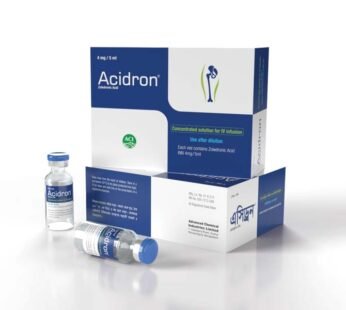Zofra ODT 8 mg
Description
Zofra ODT Oral Soluble Film
Description Zofra ODT oral soluble film is an easy-to-use, fast-dissolving film designed for placement on the tongue. Within 20 seconds, it dissolves and can be swallowed with saliva, eliminating the need for water. The active ingredient, ondansetron base, is the racemic form of ondansetron and functions as a selective serotonin 5-HT3 receptor antagonist. The molecular formula of ondansetron is C18H19N3O, with a molecular weight of 293.3.
Pharmacology Ondansetron is a potent and highly selective antagonist of 5-HT3 receptors. Although its exact mechanism in controlling nausea and vomiting is not completely understood, it is believed to work by blocking serotonin-induced activation of vagal afferents in the small intestine, preventing the vomiting reflex. Additionally, ondansetron may inhibit serotonin release in the area postrema, contributing to its antiemetic effects. This dual action is responsible for its effectiveness in managing nausea and vomiting associated with chemotherapy, radiotherapy, and surgery.
Dosage and Administration
Chemotherapy-Induced Nausea and Vomiting:
- Adults and Pediatric Patients (6 months – 18 years):
- 8 mg tablet/orodispersible tablet: Three doses of 0.15 mg/kg, with a maximum of 16 mg per dose.
- 4 mg orodispersible tablet: Three doses of 0.15 mg/kg, with a maximum of 16 mg per dose.
- Injection: Three doses of 0.15 mg/kg, up to a maximum of 16 mg per dose, administered intravenously over 15 minutes.
Radiotherapy-Induced Nausea and Vomiting:
- Adults:
- 8 mg tablet/orodispersible tablet: Initial dose of 8 mg taken 1-2 hours before radiotherapy, followed by 8 mg every 8 hours for up to 5 days.
- Injection: Three doses of 0.15 mg/kg, up to a maximum of 16 mg per dose, administered intravenously over 15 minutes.
Postoperative Nausea and Vomiting:
- Adults:
- 8 mg tablet/orodispersible tablet: 16 mg total, taken as two 8 mg tablets.
- Injection: 4 mg dose.
- Pediatrics (>40 kg): 4 mg injection.
- Pediatrics (<40 kg): 0.1 mg/kg injection.
Oral Solution Dosage:
- Chemotherapy-Induced Nausea and Vomiting:
- Adults (including elderly) and children ≥12 years: 30 ml (24 mg) for highly emetogenic chemotherapy; 10 ml (8 mg) for moderate emetogenic chemotherapy, with follow-up doses after 8 hours and continued twice daily for 1-2 days post-chemotherapy.
- Pediatric Patients (4-11 years): 5 ml (4 mg) taken 30 minutes before chemotherapy, with additional doses at 4 and 8 hours, followed by 5 ml three times daily for 1-2 days.
- Radiotherapy-Induced Nausea and Vomiting:
- Adults and children ≥12 years: 10 ml (8 mg) three times daily.
- For total body irradiation, single high-dose radiotherapy, or fractionated radiotherapy, dosing schedules vary but typically include an 8 mg dose 1-2 hours before treatment, followed by additional doses.
- Postoperative Nausea and Vomiting:
- Adults and children ≥12 years: 20 ml (16 mg) taken one hour before anesthesia.
Oral Soluble Film Administration:
- Carefully tear the pouch along the marked edge.
- Place the film on the tongue and allow it to dissolve (within 20 seconds).
- Do not chew or swallow the film whole.
- Swallow the dissolved film with or without liquid.
- Wash hands after use.
Drug Interactions Ondansetron does not significantly induce or inhibit the hepatic cytochrome P-450 enzyme system. However, inducers or inhibitors of these enzymes may affect its metabolism. No dosage adjustment is recommended based on current data.
Contraindications
- Hypersensitivity to ondansetron or any of its components.
- Concomitant use with apomorphine.
Side Effects Common side effects include headache, constipation, and diarrhea, which are generally mild to moderate. Less frequent reactions include skin rash, sensations of warmth, hiccups, and transient liver enzyme abnormalities. Rare but serious adverse effects include anaphylaxis, bronchospasm, tachycardia, chest pain, hypokalemia, and shortness of breath.
Use During Pregnancy and Lactation Animal studies have not shown harmful effects on fertility or fetal development. However, there are no adequate studies in pregnant women, so caution is advised. Ondansetron is excreted in rat breast milk, and its safety in breastfeeding humans has not been established.
Precautions and Warnings
- Patients with hypersensitivity to other 5-HT3 antagonists may experience similar reactions.
- Ondansetron does not stimulate gastric motility and should not be used as a substitute for nasogastric suction.
- In patients recovering from abdominal surgery or undergoing chemotherapy, its use may mask progressive ileus or gastric distension.
Special Populations
- Renal Impairment: No dosage adjustment needed.
- Hepatic Impairment: In severe cases, a maximum daily dose of 8 mg infused over 15 minutes is recommended.
- Children <4 years: Limited data available on dosing.
- Elderly: No dosage adjustment required.
Therapeutic Class Anti-emetic drugs.
Storage Conditions Store in a dry place at temperatures not exceeding 30ºC. Protect from light and moisture.
Additional information
| Weight | 1.15 g |
|---|








Reviews
There are no reviews yet.